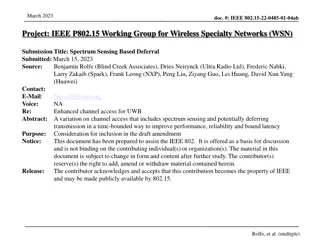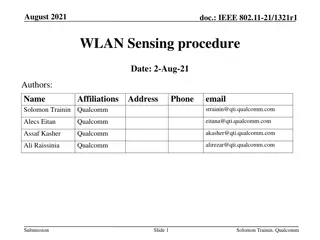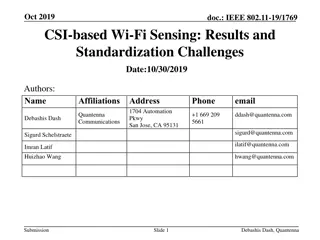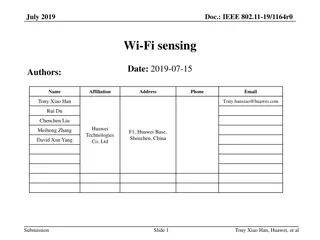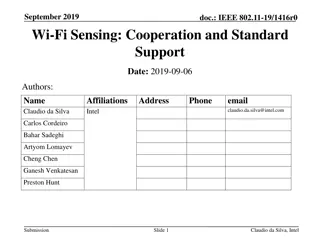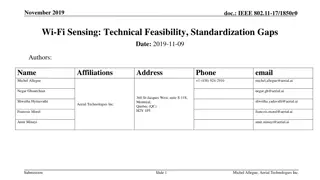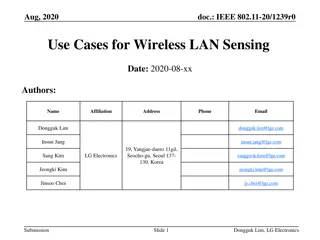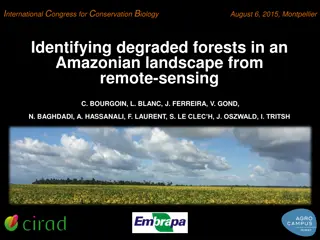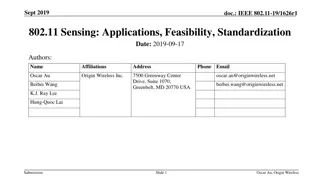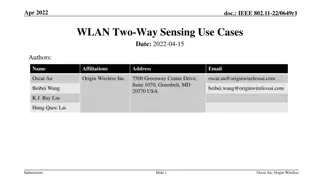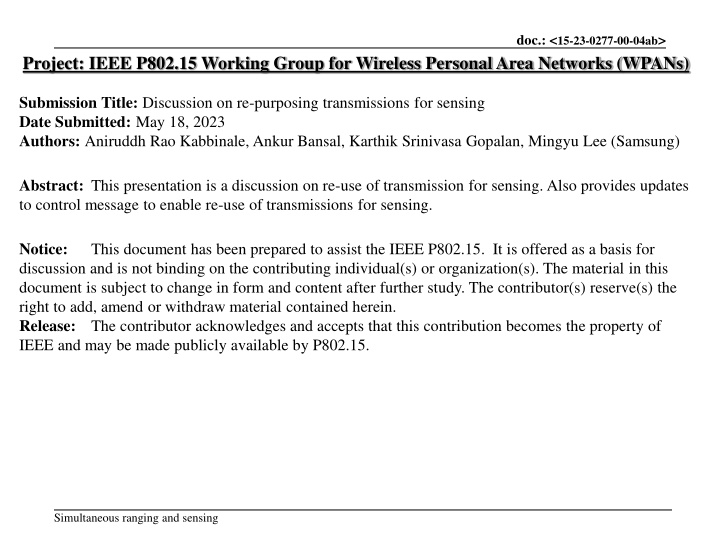
Discussion on Repurposing Transmissions for Sensing in Wireless Networks
Explore how to repurpose transmission signals for sensing in wireless personal area networks. The presentation discusses using non-sensing transmissions for sensing, updates for enabling simultaneous operation, and the use of ranging and data communication packets for sensing measurements. Dive into scenarios, packet configurations, and MMS ranging fragments for effective simultaneous ranging and sensing operations.
Download Presentation

Please find below an Image/Link to download the presentation.
The content on the website is provided AS IS for your information and personal use only. It may not be sold, licensed, or shared on other websites without obtaining consent from the author. If you encounter any issues during the download, it is possible that the publisher has removed the file from their server.
You are allowed to download the files provided on this website for personal or commercial use, subject to the condition that they are used lawfully. All files are the property of their respective owners.
The content on the website is provided AS IS for your information and personal use only. It may not be sold, licensed, or shared on other websites without obtaining consent from the author.
E N D
Presentation Transcript
doc.: <15-23-0277-00-04ab> Project: IEEE P802.15 Working Group for Wireless Personal Area Networks (WPANs) Submission Title: Discussion on re-purposing transmissions for sensing Date Submitted: May 18, 2023 Authors: Aniruddh Rao Kabbinale, Ankur Bansal, Karthik Srinivasa Gopalan, Mingyu Lee (Samsung) Abstract: This presentation is a discussion on re-use of transmission for sensing. Also provides updates to control message to enable re-use of transmissions for sensing. Notice: discussion and is not binding on the contributing individual(s) or organization(s). The material in this document is subject to change in form and content after further study. The contributor(s) reserve(s) the right to add, amend or withdraw material contained herein. Release: The contributor acknowledges and accepts that this contribution becomes the property of IEEE and may be made publicly available by P802.15. This document has been prepared to assist the IEEE P802.15. It is offered as a basis for Simultaneous ranging and sensing
doc.: <15-23-0277-00-04ab> Background In this set of slides, we discuss use of non-sensing transmissions to perform sensing. Use of ranging packet formats for sensing Use of data comm packets to perform sensing Use of MMS ranging transmissions for sensing Updates to control and scheduling information to enable simultaneous operation Considering 2 scenarios Scenario A Scenario B Ranging response from Device B Device B Single Tx from Device A Device A Device B Device A Single Tx from Device A Sensing and Ranging response from Device B Device C Sensing response from Device C Simultaneous ranging and sensing Aniruddh et.al. (Samsung) Slide 2
doc.: <15-23-0277-00-04ab> Use of ranging & data comm packets for Sensing Sensing measurements to be made on SYNC preamble HPRF Ranging sequences of Ipatov 91, with L= 4 spreading to be used agreed for sensing. Also BPRF sequences, ipatov 127 codes optionally supported for sensing CIR reporting may also be done over other parts of packer STS, Payload Sensing packet transmissions are mostly from one requesting device where as ranging messages in TWR is from multiple devices. Ranging transmissions from one device to be used to perform sensing This is conveyed in scheduling information. STS Packet configuration 0 PHR Payload SFD SYNC Mandatory STS Packet configuration 1 Payload SFD SYNC STS PHR Mandatory STS Packet configuration 2 SFD PHR STS SYNC Payload Optional STS Packet configuration 2 Mandatory SYNC SFD STS Simultaneous ranging and sensing Aniruddh et.al. (Samsung) Slide 3
doc.: <15-23-0277-00-04ab> MMS ranging fragments for sensing Typical MMS ranging packet has RSFs and RIFs (DCN 23-0128) Optional l-91 ipatov codes with L=4 spreading to be used for MMRS in this operation SYNC fragments and RSF used for performing sensing on top of MMS ranging MMS exchanges may be two way MMS RSFs from one device used for sensing Simultaneous ranging and sensing Aniruddh et.al. (Samsung) Slide 4
doc.: <15-23-0277-00-04ab> sensing control information Application Control IE (AC IE) (23-061r0, 23-021r1) Octets: 2 0/4 0/1 0/1 0/2 0/TBD 0/TBD Data Comm Control 0/TBD 0/TBD Content Control Block Duration Round Duration Slot Ranging Control Sensing Control TDoA Control Session ID Duration Sensing control updated as per DCN 23-0126. Proposal in DCN 23-178 accommodated, doesn t need any update in this field. Present if frequency stitching enabled Bits: 0-1 2-3 4 5 1-4 Base channel number or channel number 3 6-7 0 5-6 7-8 9-10 11- Process CIR report for Range/Velo city Process CIR report for AOA measureme nt Re-purpose transmissio n parameters present Carrier frequency grid configurati on ID Sensing Packet format Frequency stitching direction Sensing mode Aggregated Bandwidth Feedback control reserved reserved Re-purposed transmission for sensing control field. If ranging is re-used for sensing, use configuration in ranging control for packet format and other details. If data comm is re-used for sensing, use configuration in data comm control If MMS tx is re-used, use configuration from MMS ranging control field? (0) Use ranging packet, (1) Use data comm packet, (2) Use MMS ranging packet CIR from sync only or also other parts of packet to be indicated. 0 CIR report from SYNC only. (RSF only in MMS) 1 CIR report from SYNC and other fragments: STS (RIF for MMS ranging), PHY payload. Simultaneous ranging and sensing Aniruddh et.al. (Samsung) Slide 5
doc.: <15-23-0277-00-04ab> Scheduling IE Content of this slide is from DCN 23-063r0 and DCN 23-0136r1 The Scheduling IE is used by the controller to schedule slots to be used by intended device. Bits: 0 3 4-6 7 8 9-10 11 12-15 Octets: variable Scheduling List Scheduling List Length Scheduling List Type Address size Receiver address present Activity Indicator for Re-use of transmission for sensing Reserved In scenario A Activity would be ranging /data and indicator for re-use of transmission flag would be set to 1 In scenario B Activity for Device B would be ranging and Indicator for re-use of tx flag would not be set. Activity for Device C would be sensing and indicator for re-use of tx flag would be set to indicate the packet used would be of ranging. For Device C Re-purpose tx in sensing control gives more details about packet used and other config. Simultaneous ranging and sensing
doc.: <15-23-0277-00-04ab> Sensing Packet Structure Segments o We agree that in the baseline mandatory mode, SENS field has one segment. o We agree on optional support for 2, 3 and 4 segments in the SENS field. Gap o We agree that SENS field includes silent intervals called gaps When multiple segments are used, we agree to include gaps between segments. The duration of each gap interval is one SENS symbol. See next slides for figures RMARKER o We agree to have one RMARKER for sensing packets. The position of the RMARKER is at the peak of first pulse after SFD (as per 4z). Simultaneous ranging and sensing Slide 7 Aniruddh et.al. (Samsung)
doc.: <15-23-0277-00-04ab> Sensing Packet Structure Number of SENS Symbols o Each symbol corresponds to one period of SENS sequence with spreading o We agree to support 32, 64, 128 (Mandatory) 16, 256, 512 (optional) symbols per segment for SENS. o Sequence selection We agree that when both SENS and SYNC use length 91 Ipatov sequence, they shall use same Ipatov code index. CIR Report o For sensing packets, we agree to support one CIR report per SENS segment per Rx. Simultaneous ranging and sensing Slide 8 Aniruddh et.al. (Samsung)
doc.: <15-23-0277-00-04ab> Sensing Packet Fields We agree on the following values for SYNC and SFD configs for sensing packets o SYNC PSR: 32, 64 (mandatory), 16, 128, 256 (optional). o SFD length: Same as 15.4z, as specified in table 15-7c. o For sensing, we agree that fixed PSR is negotiated at higher layers, and the value does not change from packet to packet. We agree to use 4z PHR, with payload data rates of 1.95, 7.8, 31.2, 62.4 (mandatory), and 124.8Mbps (optional). o FEC: We agree on BCC K=7 as the FEC for SNES1 and SENS2 packets. Simultaneous ranging and sensing Slide 9 Aniruddh et.al. (Samsung)



